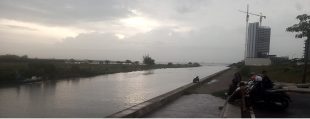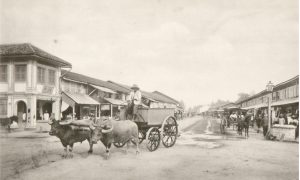Editor’s note for new subscribers: this piece appears as part of New Mandala’s ARTSEA series. Edited by the Australian National University’s Dr Elly Kent, ARTSEA features regular commentary and essays on art, design and architecture in Southeast Asia. You can visit the ARTSEA homepage here.
It has long been the case that art biennials are almost impossible to witness in their entirety. Since the proliferation of media, contemporary art has been characterised by lively projects rather than static monolithic works, including artistic-research approaches and collaboration with non-artistic practitioners. This tendency is also evident in the Biennale Jogja this year. The Biennale has entered its new phase, as the first round of the Biennale Jogja Equator series was finalised two years ago. For the 17th Biennale, which also marks the beginning the second round of the Equator series, the Biennale Jogja presents Titen: Embodied Knowledge-Shifting Ground as the title of the whole event.
Within a few days’ trip to Jogja, I visited all the sites for the biennale, including the main venue at Bentara Budaya Yogyakarta, and the twelve sites hosted across two village partners: Panggungharjo and Bangunjiwo. Before I began my trip, I wondered what the future of Biennale Jogja would be after the first round of the Equator series (2011–21). After experiencing the 17th edition, I could see the hints of where they are heading for the next few editions, and the challenges that might appear along the way.
A little background: Biennale Jogja was inaugurated in 1988 as a painting exhibition, namely Biennale Seni Lukis Yogyakarta (Yogyakarta Painting Biennale), one of the earliest biennials in the country after the Jakarta Biennale. As with many big art exhibitions in the country, the form and modes of production have evolved based on how art practitioners define contemporary art at the time.
In Jakarta, we might mention the ninth edition of the Jakarta Biennale, in 1993, curated by Jim Supangkat, as a landmark contemporary art exhibition. Its internationalisation started in the 2009 edition. Whereas in Jogja, the Biennale was already showing a fascinating approach to the exhibition-making before the Equator Project began. For instance, in 2005, the Biennale was placed in several heritage sites within the city; and in 2009 “Jogja Jamming” offered public spaces as the sites for the Biennale along with art spaces. Since then, it could be argued that the Biennale has been presented beyond a classical mode of exhibition making.
The land moves west
Artists at the Makassar Biennale grapple with the social and environmental consequences of land reclamation.
There’s a more intriguing interpretation in the current Biennale Jogja. As part of the new series, which will run from 2023–2027, I see Titen offering a deeper focus on critiquing modern epistemology that is still rooted in contemporary art—in all parts of the world, especially in the West with its powerful museum and biennial tradition. Rather than being an alternative, Titen is presented as an “option” (I refer here to Mignolo’s concept of the decolonial option) to interpret the global and/or international as a meeting of the trans-local.
Titen or niteni (lit. observation) in Javanese, is defined as the ability to read signs from nature. Titen is usually used to read natural phenomena related to disaster or to decide on the actions needed to anticipate natural phenomena. This choice of word underlines a curatorial framework that departs from the idea of decolonising knowledge production, which has become a key form of resistance to dominant Western methodologies. As stated by the biennale curators in the Guide Book, this title also emphasises curatorial methods that originate from a life involving human and non-human relations, as well as the vast natural environment.
Against this backdrop, I see the epistemological critique as a curatorial articulation that will be very important for the future of the Biennale Jogja. Through this idea, they could move away from being the alternative, and instead be an option to revisit contemporary cultural practices and knowledge structures through contemporary art. Regardless of the preferred geographical allies in the future, this idea touches upon a fundamental conceptualisation of decolonial thinking: to understand the persistence of coloniality in the legacies of imperialism and current world structures and to comprehend how western modes of thought and knowledge systems have been universalised. Therefore, in future Biennale Jogja iterations we should expect a more nuanced articulation to dismantle dominant patterns in the current contemporary art world.
Within the context of the 17th Biennale Jogja, the open discursive environment made space for the Examining Kinship installation by Manita Newa Khadgi and Mimi (Kathmandu), which articulated The Split Attraction Model in the experience of attraction and intimacy in human relationships. On the other hand, the Videoage Collective from Labuan Bajo displayed an installation titled Roko Molas Poco (2023), inspired by the role and position of women as people who are responsible for household affairs and ensuring the lives of all family members, as described on its exhibition labels. The Nepali artists urge critical evaluation of gender/human relationships against cisheteronormativity and allonormativity; by contrast Videoage Collective’s installation is based on how women are positioned within traditional values systems.
I argue that the critical point of view in these cases not only applies to the Western way of thinking but also to certain traditional beliefs. In other words, decolonisation of knowledge also needs to consider other existing values that perpetuate social norms about certain groups in society. Unless they are considered critically, some works in the biennale may seem merely exotic to some audiences, emphasising postmodern ideas. For instance, the inclusion of craft and traditional art practices demonstrates a reaction against the values of modernity, rather than decolonial thinking.
Although it is not intended to be merely a cohesive biennial exhibition, this iteration of Biennale Jogja still feels like scattered small to medium-sized exhibitions in various places. The challenge is not only how to orchestrate the whole show, but also how the audience is expected to experience the biennale. It feels insufficient to have seen all the installed works, knowing that I missed the performative part of the Biennale, particularly during the opening week when almost all the invited artists, curators, and guests were present in Jogja. I also missed plenty of programming including Biennale fora, performances and movie screenings. It is not an exaggeration to say that no one except the organisers themselves would ever be able to wade through all of these. Or perhaps this type of exhibition is not intended to be seen as a whole?
Let’s assume that the Biennale doesn’t expect us to digest all the programs on the run, but rather just to taste a few dishes. My point is not to simplify the idea of biennial as an event, but to draw attention to how the biennial is formed as a site for experiences that assert and embrace artistic idiosyncrasy. In the case of Titen, more work needed to be done as accessibility issues and lack of clear information led to some places seeming incoherent.
Writing up my experience, I’m led to the conclusion that the 17th Biennale Jogja offers how we can see decolonial thinking in the art around us. It is not so much about how to be an alternative in a clamorous contemporary art scene, rather, it made me ponder how the idea of the biennale could touch upon the existing values and beliefs in society. The critical point of view remains necessary if we are to avoid othering locals in the context of biennial spectatorship. It seems crucial that the institutions accommodate different ways of thinking, and moderate vigorous discourse along with presenting dynamic works of art as a necessary part of Biennale Jogja.
 Facebook
Facebook  Twitter
Twitter  Soundcloud
Soundcloud  Youtube
Youtube  Rss
Rss 


